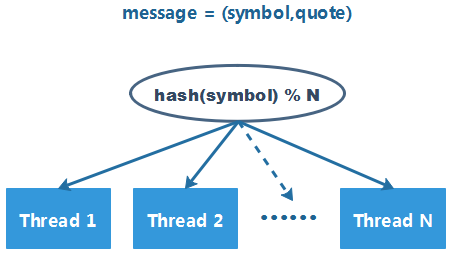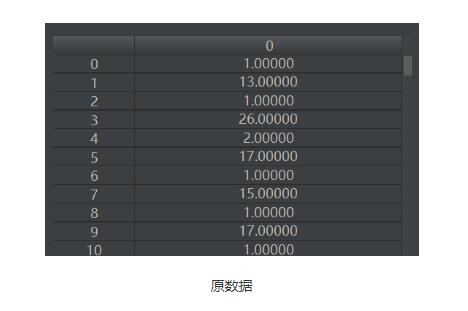如何使用Java模擬退火算法優化Hash函數
現有個處理股票行情消息的系統,其架構如下:

由于數據量巨大,系統中啟動了 15 個線程來消費行情消息。消息分配的策略較為簡單:對 symbol 的 hashCode 取模,將消息分配給其中一個線程進行處理。 經過驗證,每個線程分配到的 symbol 數量較為均勻,于是系統愉快地上線了。
運行一段時間后,突然收到了系統的告警,但此時并非消息峰值時間段。經過排查后,發現問題出現在 hash 函數上:

雖然每個線程被分配到的 symbol 數量較為均衡,但是部分熱門 symbol 的報價消息量會更多,如果熱門 symbol 集中到特定線程上,就會造成線程負載不均衡,使得系統整體的吞吐量大打折扣。
為提高系統的吞吐量,有必要消息分發邏輯進行一些改造,避免出現熱點線程。為此,系統需要記錄下某天內每個 symbol 的消息量,然后在第二天使用這些數據,對分發邏輯進行調整。具體的改造的方案可以分為兩種:
放棄使用 hash 函數 對 hash 函數進行優化二、放棄 hash 函數問題可以抽象為:
將 5000 個非負整數分配至 15 個桶(bucket)中,并盡可能保證每個桶中的元素之和接近(每個桶中的元素個數無限制)。
每個整數元素可能的放置方法有 15 種,這個問題總共可能的解有 155000種,暴力求解的可能性微乎其微。作為工程問題,最優解不是必要的,可以退而求其次尋找一個可接受的次優解:
根據所有 symbol 的消息總數計算一個期望的分布均值(expectation)。將每個 symbol 的消息數按照 symbol 的順序進行排列,最后將這組數組劃分為 15 個區間,并且盡可能使得每個區間元素之和與 expection 接近。使用一個有序查找表記錄每個區間的首個 symbol,后續就可以按照這個表對數據進行劃分。
public class FindBestDistribution { static final int NUM_OF_SYMBOLS = 5000; static final int NUM_OF_BUCKETS = 15; public static void main(String[] args) {// 生成樣本IntStream ints = ThreadLocalRandom.current().ints(0, 1000);PrimitiveIterator.OfInt iterator = ints.iterator();Map<String,Integer> symbolAndCount = new TreeMap<>();for (int i=0; i<NUM_OF_SYMBOLS; i++) { symbolAndCount.put(Integer.toHexString(i).toUpperCase(), iterator.next());}// 按照 symbol 劃分每個桶的數量TreeMap<String, Integer> distribution = findBestDistribution(symbolAndCount);// 測試效果int[] buckets = new int[NUM_OF_BUCKETS];for (Map.Entry<String, Integer> entry : symbolAndCount.entrySet()) { Map.Entry<String, Integer> floor = distribution.floorEntry(entry.getKey()); int bucketIndex = floor == null ? 0 : floor.getValue(); buckets[bucketIndex] += entry.getValue();}System.out.printf('buckets: %sn', Arrays.toString(buckets)); } public static TreeMap<String, Integer> findBestDistribution(Map<String,Integer> symbolAndCount) {// 每個桶均勻分布的情況(最優情況)int avg = symbolAndCount.values().stream().mapToInt(Integer::intValue).sum() / NUM_OF_BUCKETS;// 嘗試將 symbol 放入不同的桶int bucketIdx = 0;int[] buckets = new int[NUM_OF_BUCKETS];String[] bulkheads = new String[NUM_OF_BUCKETS-1];for (Map.Entry<String, Integer> entry : symbolAndCount.entrySet()) { // 如果首個 symbol 數據量過大,則分配給其一個獨立的桶 int count = entry.getValue(); if (count / 2 > avg && bucketIdx == 0 && buckets[0] == 0) {buckets[bucketIdx] += count;continue; } // 評估將 symbol 放入桶后的效果 // 1. 如果桶中的數量更接近期望,則將其放入當前桶中 // 2. 如果桶中的數量更遠離期望,則將其放入下個桶中 double before = Math.abs(buckets[bucketIdx] - avg); double after = Math.abs(buckets[bucketIdx] + count - avg); if (after > before && bucketIdx < buckets.length - 1) {bulkheads[bucketIdx++] = entry.getKey(); } buckets[bucketIdx] += count;}System.out.printf('expectation: %dn', avg);System.out.printf('bulkheads: %sn', Arrays.toString(bulkheads));TreeMap<String,Integer> distribution = new TreeMap<>();for (int i=0; i<bulkheads.length; i++) { distribution.put(bulkheads[i], i+1);}return distribution; }}
該方法存在的問題:
分配策略并不是最優解,且無法對其分片效果進行直觀的評估。 當區間數量較多時,查找表本身可能成為一個潛在的性能瓶頸。 可能的組合受到 key 的順序限制,極大地限制了可能的解空間。三、優化 hash 函數換個角度來看,造成分布不均勻的原因不是數據,而是 hash 函數本身。
項目中使用的 hash 函數是 JDK String 中的原生實現。經過查閱資料,發現該實現其實是 BKDRHash 的 seed = 31 的特殊情況。這樣意味著:通過調整 seed 的值,可以改變 hash 函數的特性并使其適配特定的數據分布。
int BKDRHash(char[] value, int seed) { int hash = 0; for (int i = 0; i < value.length; i++) {hash = hash * seed + value[i]; } return hash & 0x7fffffff;}
那么問題來了,應該如何評估某個 seed 的分布的優劣?
3.1、評價函數一種可行的方法是計算每個 seed 對應的 bucket 分布的標準差,標準差越小則分布越均勻,則該 seed 越優。
然而這一做法只考慮了每個 bucket 與均值之間的誤差,無法量化不同 bucket 之間的誤差。為了能夠直觀的量化 bucket 之間分布差異的情況,考慮使用下面的評估函數:
ouble calculateDivergence(long[] bucket, long expectation) { long divergence = 0; for (int i=0; i<bucket.length; i++) {final long a = bucket[i];final long b = (a - expectation) * (a - expectation);for (int j=i+1; j<bucket.length; j++) { long c = (a - bucket[j]) * (a - bucket[j]); divergence += Math.max(b, c);} } return divergence; // the less the better}
該數值越小,則證明 seed 對應的分布越均勻,其對應的 hash 函數越優。
3.2、訓練策略seed 是一個 32bit 的無符號整數,其取值范圍為 0 ~ 232-1。在 5000 個 symbol 的情況下,單線程嘗試遍歷所有 seed 的時間約為 25 小時。
通常情況下 symbol 的數量會超過 5000,因此實際的搜索時間會大于這個值。此外,受限于計算資源限制,無法進行大規模的并行搜索,因此窮舉法的耗時是不可接受的。
幸好本例并不要求最優解,可以引入啟發式搜索算法,加快訓練速度。由于本人在這方面并不熟悉,為了降低編程難度,最終選擇了模擬退火(simulated annealing)算法。它模擬固體退火過程的熱平衡問題與隨機搜索尋優問題的相似性來達到尋找全局最優或近似全局最優的目的。相較于最簡單的爬山法,模擬退火算法通以一定的概率接受較差的解,從而擴大搜索范圍,保證解近似最優。
/** * Basic framework of simulated annealing algorithm * @param <X> the solution of given problem */public abstract class SimulatedAnnealing<X> { protected final int numberOfIterations; // stopping condition for simulations protected final double coolingRate;// the percentage by which we reduce the temperature of the system protected final double initialTemperature; // the starting energy of the system protected final double minimumTemperature; // optional stopping condition protected final long simulationTime; // optional stopping condition protected final int detectionInterval; // optional stopping condition protected SimulatedAnnealing(int numberOfIterations, double coolingRate) {this(numberOfIterations, coolingRate, 10000000, 1, 0, 0); } protected SimulatedAnnealing(int numberOfIterations, double coolingRate, double initialTemperature, double minimumTemperature, long simulationTime, int detectionInterval) {this.numberOfIterations = numberOfIterations;this.coolingRate = coolingRate;this.initialTemperature = initialTemperature;this.minimumTemperature = minimumTemperature;this.simulationTime = simulationTime;this.detectionInterval = detectionInterval; } protected abstract double score(X currentSolution); protected abstract X neighbourSolution(X currentSolution); public X simulateAnnealing(X currentSolution) {final long startTime = System.currentTimeMillis();// Initialize searchingX bestSolution = currentSolution;double bestScore = score(bestSolution);double currentScore = bestScore;double t = initialTemperature;for (int i = 0; i < numberOfIterations; i++) { if (currentScore < bestScore) {// If the new solution is better, accept it unconditionallybestScore = currentScore;bestSolution = currentSolution; } else {// If the new solution is worse, calculate an acceptance probability for the worse solution// At high temperatures, the system is more likely to accept the solutions that are worseboolean rejectWorse = Math.exp((bestScore - currentScore) / t) < Math.random();if (rejectWorse || currentScore == bestScore) { currentSolution = neighbourSolution(currentSolution); currentScore = score(currentSolution);} } // Stop searching when the temperature is too low if ((t *= coolingRate) < minimumTemperature) {break; } // Stop searching when simulation time runs out if (simulationTime > 0 && (i+1) % detectionInterval == 0) {if (System.currentTimeMillis() - startTime > simulationTime) break; }}return bestSolution; }}/** * Search best hash seed for given key distribution and number of buckets with simulated annealing algorithm */@Datapublic class SimulatedAnnealingHashing extends SimulatedAnnealing<HashingSolution> { private static final int DISTRIBUTION_BATCH = 100; static final int SEARCH_BATCH = 200; private final int[] hashCodes = new int[SEARCH_BATCH]; private final long[][] buckets = new long[SEARCH_BATCH][]; @Data public class HashingSolution {private final int begin, range; // the begin and range for searchingprivate int bestSeed; // the best seed found in this searchprivate long bestScore; // the score corresponding to bestSeedprivate long calculateDivergence(long[] bucket) { long divergence = 0; for (int i=0; i<bucket.length; i++) {final long a = bucket[i];final long b = (a - expectation) * (a - expectation);for (int j=i+1; j<bucket.length; j++) { long c = (a - bucket[j]) * (a - bucket[j]); divergence += Math.max(b, c);} } return divergence; // the less the better}private HashingSolution solve() { if (range != hashCodes.length) {throw new IllegalStateException(); } for (int i=0; i<range; i++) {Arrays.fill(buckets[i], hashCodes[i] = 0); } for (KeyDistribution[] bucket : distributions) {for (KeyDistribution distribution : bucket) { Hashing.BKDRHash(distribution.getKey(), begin, hashCodes); for (int k = 0; k< hashCodes.length; k++) {int n = hashCodes[k] % buckets[k].length;buckets[k][n] += distribution.getCount(); }} } int best = -1; long bestScore = Integer.MAX_VALUE; for (int i = 0; i< buckets.length; i++) {long score = calculateDivergence(buckets[i]);if (i == 0 || score < bestScore) { bestScore = score; best = i;} } if (best < 0) {throw new IllegalStateException(); } this.bestScore = bestScore; this.bestSeed = begin + best; return this;}@Overridepublic String toString() { return String.format('(seed:%d, score:%d)', bestSeed, bestScore);} } private final KeyDistribution[][] distributions; // key and its count(2-dimensional array for better performance) private final long expectation; // the expectation count of each bucket private final int searchOutset; private int searchMin, searchMax; /** * SimulatedAnnealingHashing Prototype * @param keyAndCounts keys for hashing and count for each key * @param numOfBuckets number of buckets */ public SimulatedAnnealingHashing(Map<String, Integer> keyAndCounts, int numOfBuckets) {super(100000000, .9999);distributions = buildDistribution(keyAndCounts);long sum = 0;for (KeyDistribution[] batch : distributions) { for (KeyDistribution distribution : batch) {sum += distribution.getCount(); }}this.expectation = sum / numOfBuckets;this.searchOutset = 0;for (int i = 0; i< buckets.length; i++) { buckets[i] = new long[numOfBuckets];} } /** * SimulatedAnnealingHashing Derivative * @param prototype prototype simulation * @param searchOutset the outset for searching * @param simulationTime the expect time consuming for simulation */ private SimulatedAnnealingHashing(SimulatedAnnealingHashing prototype, int searchOutset, long simulationTime) {super(prototype.numberOfIterations, prototype.coolingRate, prototype.initialTemperature, prototype.minimumTemperature,simulationTime, 10000);distributions = prototype.distributions;expectation = prototype.expectation;for (int i = 0; i< buckets.length; i++) { buckets[i] = new long[prototype.buckets[i].length];}this.searchOutset = searchOutset;this.searchMax = searchMin = searchOutset; } @Override public String toString() {return String.format('expectation: %d, outset:%d, search(min:%d, max:%d)', expectation, searchOutset, searchMin, searchMax); } private KeyDistribution[][] buildDistribution(Map<String, Integer> symbolCounts) {int bucketNum = symbolCounts.size() / DISTRIBUTION_BATCH + Integer.signum(symbolCounts.size() % DISTRIBUTION_BATCH);KeyDistribution[][] distributions = new KeyDistribution[bucketNum][];int bucketIndex = 0;List<KeyDistribution> batch = new ArrayList<>(DISTRIBUTION_BATCH);for (Map.Entry<String, Integer> entry : symbolCounts.entrySet()) { batch.add(new KeyDistribution(entry.getKey().toCharArray(), entry.getValue())); if (batch.size() == DISTRIBUTION_BATCH) {distributions[bucketIndex++] = batch.toArray(new KeyDistribution[0]);batch.clear(); }}if (batch.size() > 0) { distributions[bucketIndex] = batch.toArray(new KeyDistribution[0]); batch.clear();}return distributions; } @Override protected double score(HashingSolution currentSolution) {return currentSolution.solve().bestScore; } @Override protected HashingSolution neighbourSolution(HashingSolution currentSolution) {// The default range of neighbourhood is [-100, 100]int rand = ThreadLocalRandom.current().nextInt(-100, 101);int next = currentSolution.begin + rand;searchMin = Math.min(next, searchMin);searchMax = Math.max(next, searchMax);return new HashingSolution(next, currentSolution.range); } public HashingSolution solve() {searchMin = searchMax = searchOutset;HashingSolution initialSolution = new HashingSolution(searchOutset, SEARCH_BATCH);return simulateAnnealing(initialSolution); } public SimulatedAnnealingHashing derive(int searchOutset, long simulationTime) {return new SimulatedAnnealingHashing(this, searchOutset, simulationTime); }}3.3、ForkJoin 框架
為了達到更好的搜索效果,可以將整個搜索區域遞歸地劃分為兩兩相鄰的區域,然后在這些區域上執行并發的搜索,并遞歸地合并相鄰區域的搜索結果。
使用 JDK 提供的 ForkJoinPool 與 RecursiveTask 能很好地完成以上任務。
@Data@Slf4jpublic class HashingSeedCalculator { /** * Recursive search task */ private class HashingSeedCalculatorSearchTask extends RecursiveTask<HashingSolution> {private SimulatedAnnealingHashing simulation;private final int level;private final int center, range;private HashingSeedCalculatorSearchTask() { this.center = 0; this.range = Integer.MAX_VALUE / SimulatedAnnealingHashing.SEARCH_BATCH; this.level = traversalDepth; this.simulation = hashingSimulation;}private HashingSeedCalculatorSearchTask(HashingSeedCalculatorSearchTask parent, int center, int range) { this.center = center; this.range = range; this.level = parent.level - 1; this.simulation = parent.simulation;}@Overrideprotected HashingSolution compute() { if (level == 0) {long actualCenter = center * SimulatedAnnealingHashing.SEARCH_BATCH;log.info('Searching around center {}', actualCenter);HashingSolution solution = simulation.derive(center, perShardRunningMills).solve();log.info('Searching around center {} found {}', actualCenter, solution);return solution; } else {int halfRange = range / 2;int leftCenter = center - halfRange, rightCenter = center + halfRange;ForkJoinTask<HashingSolution> leftTask = new HashingSeedCalculatorSearchTask(this, leftCenter, halfRange).fork();ForkJoinTask<HashingSolution> rightTask = new HashingSeedCalculatorSearchTask(this, rightCenter, halfRange).fork();HashingSolution left = leftTask.join();HashingSolution right = rightTask.join();return left.getBestScore() < right.getBestScore() ? left : right; }} } private final int poolParallelism; private final int traversalDepth; private final long perShardRunningMills; private final SimulatedAnnealingHashing hashingSimulation; /** * HashingSeedCalculator * @param numberOfShards the shard of the whole search range [Integer.MIN_VALUE, Integer.MAX_VALUE] * @param totalRunningHours the expect total time consuming for searching * @param symbolCounts the key and it`s distribution * @param numOfBuckets the number of buckets */ public HashingSeedCalculator(int numberOfShards, int totalRunningHours, Map<String, Integer> symbolCounts, int numOfBuckets) {int n = (int) (Math.log(numberOfShards) / Math.log(2));if (Math.pow(2, n) != numberOfShards) { throw new IllegalArgumentException();}this.traversalDepth = n;this.poolParallelism = Math.max(ForkJoinPool.getCommonPoolParallelism() / 3 * 2, 1); // conservative estimation for parallelismthis.perShardRunningMills = TimeUnit.HOURS.toMillis(totalRunningHours * poolParallelism) / numberOfShards;this.hashingSimulation = new SimulatedAnnealingHashing(symbolCounts, numOfBuckets); } @Override public String toString() {int numberOfShards = (int) Math.pow(2, traversalDepth);int totalRunningHours = (int) TimeUnit.MILLISECONDS.toHours(perShardRunningMills * numberOfShards) / poolParallelism;return 'HashingSeedCalculator(' +'numberOfShards: ' + numberOfShards +', perShardRunningMinutes: ' + TimeUnit.MILLISECONDS.toMinutes(perShardRunningMills) +', totalRunningHours: ' + totalRunningHours +', poolParallelism: ' + poolParallelism +', traversalDepth: ' + traversalDepth + ')'; } public synchronized HashingSolution searchBestSeed() {long now = System.currentTimeMillis();log.info('SearchBestSeed start');ForkJoinTask<HashingSolution> root = new HashingSeedCalculatorSearchTask().fork();HashingSolution initSolution = hashingSimulation.derive(0, perShardRunningMills).solve();HashingSolution bestSolution = root.join();log.info('Found init solution {}', initSolution);log.info('Found best solution {}', bestSolution);if (initSolution.getBestScore() < bestSolution.getBestScore()) { bestSolution = initSolution;}long cost = System.currentTimeMillis() - now;log.info('SearchBestSeed finish (cost:{}ms)', cost);return bestSolution; }}3.4、效果
將改造后的代碼部署到測試環境后,某日訓練日志:
12:49:15.227 85172866 INFO hash.HashingSeedCalculator - Found init solution (seed:15231, score:930685828341164)12:49:15.227 85172866 INFO hash.HashingSeedCalculator - Found best solution (seed:362333, score:793386389726926)12:49:15.227 85172866 INFO hash.HashingSeedCalculator - SearchBestSeed finish (cost:10154898ms)12:49:15.227 85172866 INFO hash.TrainingService -Training result: (seed:362333, score:793386389726926)Buckets: 15Expectation: 44045697Result of Hashing.HashCode(seed=362333): 21327108 [42512742, 40479608, 43915771, 47211553, 45354264, 43209190, 43196570, 44725786, 41999747, 46450288, 46079231, 45116615, 44004021, 43896194, 42533877]Result of Hashing.HashCode(seed=31): 66929172 [39723630, 48721463, 43365391, 46301448, 43931616, 44678194, 39064877, 45922454, 43171141, 40715060, 33964547, 49709090, 58869949, 34964729, 47581868]
當晚使用 BKDRHash(seed=31) 對新的交易日數據的進行分片:
04:00:59.001 partition messages per minute [45171, 68641, 62001, 80016, 55977, 61916, 55102, 49322, 55982, 57081, 51100, 70437, 135992, 37823, 58552] , messages total [39654953, 48666261, 43310578, 46146841, 43834832, 44577454, 38990331, 45871075, 43106710, 40600708, 33781629, 49752592, 58584246, 34928991, 47545369]
當晚使用 BKDRHash(seed=362333) 對新的交易日數據的進行分片:
04:00:59.001 partition messages per minute [62424, 82048, 64184, 47000, 57206, 69439, 64430, 60096, 46986, 58182, 54557, 41523, 64310, 72402, 100326] , messages total [44985772, 48329212, 39995385, 43675702, 45216341, 45524616, 41335804, 44917938, 44605376, 44054821, 43371892, 42068637, 44000817, 42617562, 44652695]
對比日志發現 hash 經過優化后,分區的均勻程度有了顯著的上升,并且熱點分片也被消除了,基本達到當初設想的優化效果。
以上就是如何使用Java模擬退火算法優化Hash函數的詳細內容,更多關于Java 模擬退火算法優化Hash的資料請關注好吧啦網其它相關文章!
相關文章:

 網公網安備
網公網安備